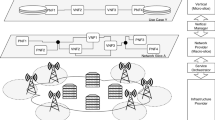Abstract
The paradigm shift from a one-size-fits-all architecture to a service-oriented network infrastructure promised by network slicing will demand novel technical solutions, as well as new business models. In particular, the role separation between infrastructure providers, i.e. the ones owning the network, and slice tenants, i.e. the ones providing specialized services tailored to their vertical segments, may encourage the definition of a shared platform (or marketplace) where the former can monetize their network infrastructure by leasing network resources at a market price, and the latter can rent on-demand the network resources needed to offer their services at the desired quality. This also enables the flexibility for the slice tenants to optimize the management of their slices by adapting their resource demand to fluctuations of their traffic or variations of the price in the market. In this paper, we extend the market mechanism scheme developed in previous works by including intra-slice radio admission control policies in the utility definition of the tenants in the slicing market game. Moreover, we characterize the mathematical properties of the game with respect to slice configuration, i.e. how diverse strategical behavior of the tenants affects the market operation, in terms of slice resource allocation and performance. Our analysis offers insights to the slice tenants on how they could reconfigure their techno-economic performance indicators in response to the dynamics of network and of the market, namely how to adapt their long-term (and/or real-time) strategies to the fluctuations of the traffic to enhance network performance and increase profits.
Access this chapter
Tax calculation will be finalised at checkout
Purchases are for personal use only
Similar content being viewed by others
Notes
- 1.
This assumption holds for simplicity. In general, a single tenant may control multiple network slices and still have different business models for each of them.
- 2.
References
3GPP TR 38.901: Study on channel model for frequencies from 0.5 to 100 GHz (2019)
5GPPP Architecture Working Group: 5G empowering vertical industries (2016). https://5g-ppp.eu/wp-content/uploads/2016/02/BROCHURE
Acemoglu, D., Jensen, M.K.: Aggregate comparative statics. Games Econom. Behav. 81, 27–49 (2013)
Andrews, M., Borst, S., Klein, S., Kroener, H., Mandelli, S.: The effect of additive and multiplicative scheduler weight adjustments on 5G slicing dynamics. In: IEEE 2nd 5G World Forum (5GWF) (2019)
Badia, L., Lindstrom, M., Zander, J., Zorzi, M.: Demand and pricing effects on the radio resource allocation of multimedia communication systems. In: IEEE Global Communications Conference (GLOBECOM) (2003)
Bega, D., Gramaglia, M., Fiore, M., Banchs, A., Costa-Perez, X.: DeepCog: cognitive network management in sliced 5G networks with deep learning. In: IEEE Conference on Computer Communications (INFOCOM) (2019)
Elayoubi, S.E., Jemaa, S.B., Altman, Z., Galindo-Serrano, A.: 5G RAN slicing for verticals: enablers and challenges. IEEE Commun. Mag. 57(1), 28–34 (2019)
Jensen, M.: Aggregative games and best-reply potentials. Econ. Theory 43, 45–66 (2010)
Jiang, M., Condoluci, M., Mahmoodi, T.: Network slicing in 5G: an auction-based model. In: IEEE International Conference on Communications (ICC) (2017)
Kelly, F.P., Maulloo, A.K., Tan, D.K.: Rate control for communication networks: shadow prices, proportional fairness and stability. J. Oper. Res. Soc. 49(3), 237–252 (1998)
Liang, L., Wu, Y., Feng, G., Jian, X., Jia, Y.: Online auction-based resource allocation for service-oriented network slicing. IEEE Trans. Veh. Technol. 68(8), 8063–8074 (2019)
Lieto, A., Malanchini, I., Mandelli, S., Moro, E., Capone, A.: Strategic network slicing management in radio access networks. IEEE Trans. Mob. Comput. (2020)
Lieto, A., Moro, E., Malanchini, I., Mandelli, S., Capone, A.: Strategies for network slicing negotiation in a dynamic resource market. In: IEEE 20th International Symposium on “A World of Wireless, Mobile and Multimedia Networks” (WoWMoM) (2019)
Malanchini, I., Valentin, S., Aydin, O.: Wireless resource sharing for multiple operators: generalization, fairness, and the value of prediction. Comput. Netw. 100, 110–123 (2016)
Peha, J.M.: Sharing spectrum through spectrum policy reform and cognitive radio. Proc. IEEE 97, 708–719 (2009)
Raza, M.R., Rostami, A., Wosinska, L., Monti, P.: A slice admission policy based on big data analytics for multi-tenant 5G networks. J. Lightwave Technol. 37(7), 1690–1697 (2019)
Vassilaras, S., et al.: The algorithmic aspects of network slicing. IEEE Commun. Mag. 55, 112–119 (2017)
Wang, G., Feng, G., Tan, W., Qin, S., Wen, R., Sun, S.: Resource allocation for network slices in 5G with network resource pricing. In: IEEE Global Communications Conference (GLOBECOM) (2017)
Wang, Q., et al.: Slicenet: end-to-end cognitive network slicing and slice management framework in virtualised multi-domain, multi-tenant 5G networks. In: IEEE International Symposium on Broadband Multimedia Systems and Broadcasting (BMSB) (2018)
Zheng, J., Caballero, P., de Veciana, G., Baek, S.J., Banchs, A.: Statistical multiplexing and traffic shaping games for network slicing. IEEE/ACM Trans. Netw. 26(6), 2528–2541 (2018)
Author information
Authors and Affiliations
Corresponding author
Editor information
Editors and Affiliations
Rights and permissions
Copyright information
© 2022 ICST Institute for Computer Sciences, Social Informatics and Telecommunications Engineering
About this paper
Cite this paper
Lieto, A., Malanchini, I., Mandelli, S., Capone, A. (2022). Dynamic Pricing for Tenants in an Automated Slicing Marketplace. In: Fang, F., Shu, F. (eds) Game Theory for Networks. GameNets 2022. Lecture Notes of the Institute for Computer Sciences, Social Informatics and Telecommunications Engineering, vol 457. Springer, Cham. https://doi.org/10.1007/978-3-031-23141-4_21
Download citation
DOI: https://doi.org/10.1007/978-3-031-23141-4_21
Published:
Publisher Name: Springer, Cham
Print ISBN: 978-3-031-23140-7
Online ISBN: 978-3-031-23141-4
eBook Packages: Computer ScienceComputer Science (R0)




